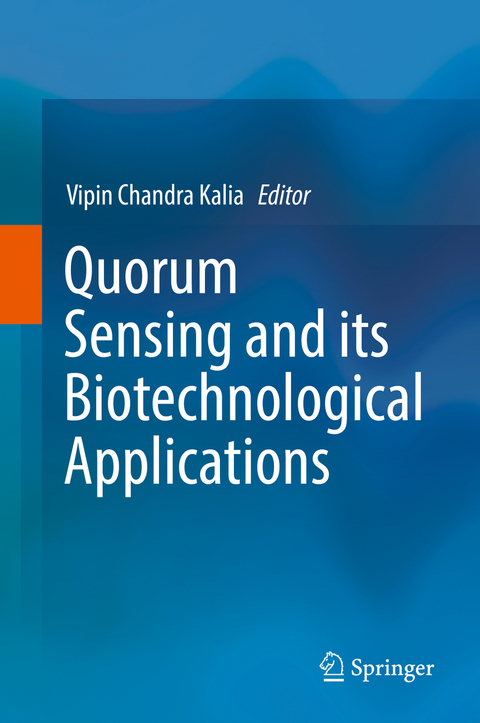
Quorum Sensing and its Biotechnological Applications
Springer Verlag, Singapore
978-981-13-0847-5 (ISBN)
The book discusses how QS can be exploited for biotechnological applications in generating bioproducts, bioenergy, bioremediation, biosensors, health and agricultural activities.
This book delves into the biotechnological applications of Quorum sensing (QS)- a peculiar gene-regulatory process of some microorganisms. Quorum Sensing allows a large bacterial population to work together in a coordinated manner to carry out metabolic activities, which individual bacterium cannot. The different chapters describe how, associating bioremediation process with energy generation is an economical proposal, for reducing pollution and managing biowastes.
The book discusses how QS can be exploited for biotechnological applications in generating bioproducts, bioenergy, bioremediation, biosensors, health and agricultural activities. It further highlights how QS is becoming an integral part of synthetic biology for genetic circuits for producing: (i) novel products, (ii) biosensors, (iii) bioactive molecules, etc. The book is divided into different sections for a clear understanding of the applicability of QS in, the Environment, Energy,Agriculture and Health sectors.
Dr. Vipin Chandra Kalia is a Professor at the Molecular Biotechnology Lab, Department of Chemical Engineering, Konkuk University, Seoul, Korea. He has been an emeritus scientist and ex-chief scientist at Microbial Biotechnology and Genomics, CSIR-Institute of Genomics and Integrative Biology, Delhi. He obtained his M.Sc. and Ph.D. degrees in Genetics from the Indian Agricultural Research Institute, New Delhi. He was elected as fellow of the Association of Microbiologists of India (FAMI), the National Academy of Sciences (FNASc), and the National Academy of Agricultural Sciences (FNAAS). His main areas of research are microbial biodiversity, genomics and evolution, bioenergy, biopolymers, antimicrobials, quorum sensing, and quorum quenching. He has published over 100 papers in scientific journals such as (1) Nature Biotechnology, (2) Biotechnology Advances, (3) Trends in Biotechnology, (4) Critical Reviews in Microbiology, (5) Bioresource Technology, (6) the International Journal of Hydrogen Energy, (7) PLoS ONE, (8) BMC Genomics, (9) Gene, and (10) the Annual Review of Microbiology. He has an h index of 32 and an i10 index of 71. He has edited 3 books: Quorum sensing versus quorum quenching: A battle with no end in sight (2015, Springer India), and Microbial Factories Vol 1 and 2 (2015). He is currently the editor-in- chief of the Indian Journal of Microbiology and editor of (1) PLoS ONE, (2) the Journal of Microbiology & Biotechnology (Korea), (3) Applied Biochemistry & Biotechnology (USA), (4) International Scholarly Research Notices (Energy), (5) Dataset Papers in Science (Microbiology), and (6) the Journal of Molecular and Genetic Medicine. He is a life member of the following scientific societies: (1) the Society of Biological Chemists of India (2) the Society for Plant Biochemistry and Biotechnology, India; (3) the Association of Microbiologists of India; (4) the Indian Science Congress Association; (5) the BioEnergy Society of India, and (6) the Biotech Research Society of India (BRSI). He is also a member of the American Society for Microbiology.
A. Environment.-1. Quorum Sensing and its Inhibition: Biotechnological Applications.- 2. Talking through Chemical Languages: Quorum Sensing and Bacterial Communication.- 3. Phylogenomics and evolutionary perspective of quorum sensing regulators (LuxI/LuxR) in prokaryotes.- 4. Technology platforms for bioanalysis of Quorum sensing system and exploiting it as Biomonitors and Biosensors.- 5. Application of Microbial Quorum Sensing Systems for Bioremediation of Wastewaters.- 6. lux gene: Quorum Sensing, Engineering and applications.- 7. Strategies behind biosensors for food and waterborne pathogens.- 8. Transcriptome: A tool for biotechnological applications of quorum sensing using single cell and viruses B. Energy.- 9. Application of Quorum Sensing Systems in Production of Green Fuels.- 10. Bacterial quorum sensing: applications of microbial fuel cells in yellow biotechnology C. Agriculture.- 11. Pseudomonas: A quorum sensing system for improved crop production.- 12. Significance and application of quorum sensing in food microbiology D. Health.- 13. Quorum Sensing Controls Costs of Bacterial CRISPR-Cas Adaptive Immune Systems.- 14. Quorum Sensing in life support systems: the MELiSSA loop.- 15. Novel Super-regulators of Quorum Sensing in Pseudomonas aeruginosa.- 16. Applications of serine/threonine protein kinases (STPK): A bus for dormancy exit.- 17. Quorum sensing talk in bacteria to make it CRISPR.- 18. Quorum sensing systems.
| Erscheinungsdatum | 18.09.2018 |
|---|---|
| Zusatzinfo | 28 Illustrations, color; 21 Illustrations, black and white; XII, 278 p. 49 illus., 28 illus. in color. |
| Verlagsort | Singapore |
| Sprache | englisch |
| Maße | 155 x 235 mm |
| Themenwelt | Medizin / Pharmazie ► Physiotherapie / Ergotherapie ► Orthopädie |
| Naturwissenschaften ► Biologie ► Genetik / Molekularbiologie | |
| Naturwissenschaften ► Biologie ► Mikrobiologie / Immunologie | |
| Technik ► Medizintechnik | |
| Technik ► Umwelttechnik / Biotechnologie | |
| ISBN-10 | 981-13-0847-0 / 9811308470 |
| ISBN-13 | 978-981-13-0847-5 / 9789811308475 |
| Zustand | Neuware |
| Haben Sie eine Frage zum Produkt? |
aus dem Bereich


